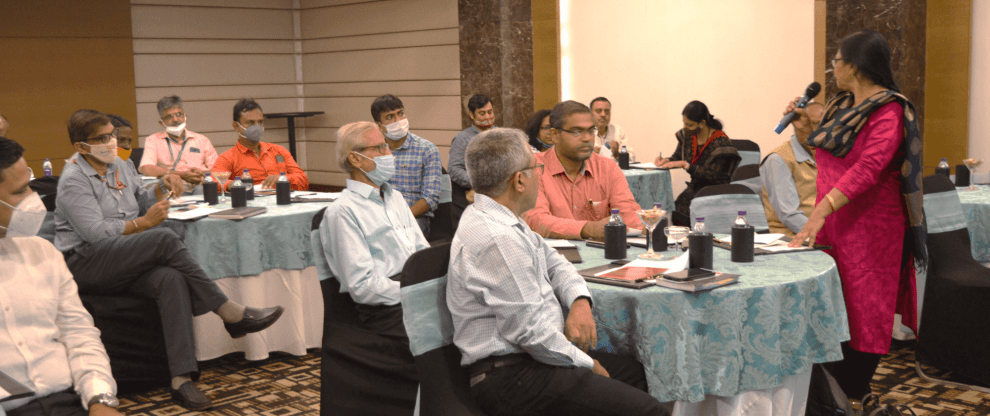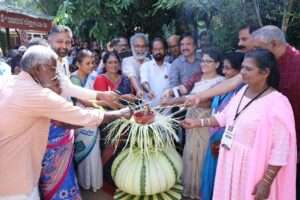Swati Nayak reflects on her participation in the CRISP–STRINGs Workshop on ‘Supporting Rice Farmers in Odisha to Adapt to Climate Change’ here.
BACKGROUND
On 5 October, 2021 a very interesting event occurred in Odisha. The Centre for Research on Innovation and Science Policy (CRISP) organized a workshop as part of the research project ‘Strengthening Research and Innovation for Global Goals (STRINGS)’, for projecting the findings of a case study done in Odisha and collating feedback and insights from diverse stakeholders. This study broadly looked at how Science Technology and Innovation (STI) contributes or not towards meeting the UN SDGs and how different STI pathways positively or negatively affect the relevant SDGs. These case studies were conducted across three countries – India, Kenya and Argentina – to primarily gather evidence on different pathways that are either aligned or misaligned to diverse STI pathways, and how they could be better steered so as to have a better alignment with SDGs.
The India case study was conducted in Odisha State which has a very rich foundation of biodiversity, especially in the domain of rice cultivation. At the same time the state continuously faces climate change induced losses in agriculture, and challenges arising from malnutrition, low income, and associated vulnerabilities among farming households. In past decades scientific innovations, especially the modern breeding programmes, have focused on high yielding, stress tolerant, biofortified varieties of rice for rice growers with the aim of tackling the challenges mentioned above. At the same time the state – by default or historically – also has regions that have witnessed several promising in situ conservation activities. These two pathways were evaluated in detail and the findings were deliberated on by diverse stakeholders who represented NGOs, researchers and extensionists from NARES, CGIAR, community institutions, farmers, seed enterprises or market experts, seed regulatory experts, and conservationists.
THE KEY TAKEAWAYS
The principal insights I have obtained are given below.
The Dilemma of Technology Integration
The in situ conservation pathways focus on restoring or maintaining the biodiversity in areas, and hence by default, the focus is around continued cultivation of traditional varieties or landraces in areas where these varieties have evolved. These varieties are often known to have low yield. They also have problems with the purity and quality of seeds being produced that are available for multiplication, scaling and further use in the value chain. In spite of yield-related challenges the unique value of these varieties remain as they have several beneficial traits such as high nutrient content (e.g., the black rice with high iron content), fragrance, superior grain quality, abiotic or biotic stress tolerance, etc. Moreover the seeds of these varieties are locally available either as farmer saved seeds or through exchange with other farmers growing such varieties in the same or adjoining villages.
In order to enhance visibility, access to quality seeds, scaling and use of these varieties of rice in consumer markets, several researchers advocate integrating some of the modern scientific practices among farmers growing these landraces and those promoting in situ conservation. However, not many attempts have been made in this area.
 But if we look at the traditional breeding programmes, many of these landraces are used as parent germplasm or base material. Unfortunately the upgraded product that results from this is no longer similar to the original genetic composition. It often leads to loss of some core traits or features. From the biodiversity conservation point of view the core germplasm is lost in the process.
But if we look at the traditional breeding programmes, many of these landraces are used as parent germplasm or base material. Unfortunately the upgraded product that results from this is no longer similar to the original genetic composition. It often leads to loss of some core traits or features. From the biodiversity conservation point of view the core germplasm is lost in the process.
There have also been several significant achievements in the form of a genebank where many such germplasms are conserved ex-situ. However, often these are not used for further scaling up, and the scaling and use of such varieties require more localized and in situ conservation for cost effective enhanced access to these seeds, as well as for increased production and linkage to consumer markets.
The innovations around seed scaling and varietal introduction programmes present a lot of avenues for scaling and adoption of targeted varieties, including landraces. However, the inherent challenge in the case of landraces is the loss of genetic composition with changes in the ecosystem through the transfer of materials from their original environment. This itself negates the principles of conservation.
The Policy and Nutrition Perspective
One of the very noteworthy traits possessed by several landraces is its nutrient content. Many of these varieties are found to be high on nutrition. In that context when the thrust of several policies and programmes are on biofortified and high nutrient food, landraces can play a critical role. While an enhanced yield – one of the major targets and outcomes of the green revolution in the region – ensured food security, the nutrition security factor is becoming increasingly essential. The seed of landraces being scaled and used for production to feed into consumer markets can indeed add great value to the nutritional drive given public good will. Convergence of various programmes, such as ICDS, Public Distribution Systems, can play a critical role.

However, so far we have been looking at the utility of landraces from a consumer perspective. We also need to think of the value for producers and growers. They would remain critical stakeholders in adoption, conservation and scaling of landraces.
Policies around incentivized or differential pricing including Minimum Support Price (MSP), refinement of grading scales of rice (that consider traits beyond grain size or yield), can help landraces in getting their due in seed systems and the production ecosystem.
Apart from this, there could also be clearly defined policies around delineating ecosystems for in situ conservation. Even though it exists by default, but in a free market era often there is no check on product inflows. The genetic materials existing from both sources (in situ and incoming) can interfere with the principles of isolation and conservation. Dedicated areas and zones for in situ conservation of landraces could be an area to explore.

Often the existing policy environment including the regulatory frames around seed, marketing, conservation, etc., interfere across both the pathways. While there are enough institutions, processes, and policies around the breeding pathway making it appear as the dominant pathway attracting more investments for decades now, in situ pathways struggle to have those dedicated provisions. To strengthen in situ conservation efforts, we need dedicated institutions, regulatory bodies as well as financing bodies that work towards this in a targeted manner – well-safeguarded through national or sub-national policies.
The national programmes must also work towards changing the entire system of recognition around existing varietal development and improvement programmes that incentivize researchers (breeders to be specific). The domains of recognition must also include the skill and ability to contribute to in situ conservation of landraces, especially traditional varieties, if at all we wish to see a structured effort at strengthening biodiversity conservation.
The Market Perspectives
While quality seed is critical to promote conservation and cultivation of landraces, the seed here needs to be considered not just as input but also as a product. While access to quality input may be essential for productivity, a product calls for more comprehensive market driven strategies. This demands strategies for positioning effort, what market to target for its scale and consumption, what value addition could be needed, what institutions and infrastructures would be critical for establishing a sustained demand as well as supply chain. These are essential elements that must be an integral part of any conservation drive.
 While grassroots institutions can be formed, strengthened for in situ conservation and product scaling activities, their capacity building in the market linkage domain would be critical. Connecting them to actors and institutions as well as processes (including regulatory ones) on the supply, production and demand side will be essential. This could be done through rigorous training and skill building of these entities through larger institutions. However, the key step will be to make sure that the larger institutions, especially the National Agricultural Research and Extension Systems (NARES) are equipped well enough to bring together these market related skills. Being traditionally research centric, their engagement with market forces is very limited. Therefore, establishing or collaborating with specialized institutions and forging private partnership models could also be a key area for further exploration.
While grassroots institutions can be formed, strengthened for in situ conservation and product scaling activities, their capacity building in the market linkage domain would be critical. Connecting them to actors and institutions as well as processes (including regulatory ones) on the supply, production and demand side will be essential. This could be done through rigorous training and skill building of these entities through larger institutions. However, the key step will be to make sure that the larger institutions, especially the National Agricultural Research and Extension Systems (NARES) are equipped well enough to bring together these market related skills. Being traditionally research centric, their engagement with market forces is very limited. Therefore, establishing or collaborating with specialized institutions and forging private partnership models could also be a key area for further exploration.
Streamlining the Seed Chain
One of the biggest challenges for the traditional varieties is the absence of a defined seed chain. While seed exchange systems are a part of tradition and culture in the studied belt, this cannot ensure quality. As quality seeds are known to contribute about 15-20% to overall productivity of a variety, positioning these varieties well within the seed systems is essential for scaling, adoption and further value addition.
There have been several efforts of late where initiatives are being taken up to collect, study and select superior accessions of landraces from their natural environment, from growers and through purification, quality seeds for multiplication are being maintained. This is serving as an intermediate method between breeding and in situ conservation pathways. While the breeding pathway has its disadvantage of changing the original genetic composition of the landrace, careful technology and skill integration in the in situ conservation pathway can serve greatly in ensuring access to quality seeds.
In situ conservation often misses skill, knowledge, infrastructure and also data around quality seed, whether it be the technology/practices of seed storage, purification process among different accessions or more. There is a need for creating localized incubation centres which can focus on these aspects and capacitate the local growers or conservationists, and also provide them with avenues to leverage improved infrastructure and technology. This can increase the availability of pure and quality seeds of landraces and also add more value to this pathway. We need additional institutional innovations to make this domain more organized.
National policies and programmes must work towards developing clear strategies and investments to provide accelerated momentum to all of the above. The robust Indian NARES should be connected to the actors in the in situ conservation pathway – to train, handhold and provide necessary technical backstopping to them so as to improve their efficiency. At the same time these actors supporting the in situ pathway can also provide fresh perspectives to the formal NARES actors on how to better align their work to relevant SDGs.

Policy innovations could also be deliberated around incentivizing the growers and conservationists of landraces (who though are not designated breeders) to follow or apply advanced and scientific knowledge for purification and quality seed maintenance, and advancement process. There could be alternative certification for these conservationists, quality labelling or branding for seeds produced through such pathways so as to provide necessary visibility, recognition and use. The scope of existing seed regulatory domains could also be revisited – including the upcoming seed bill – if these elements are to be well-integrated.
Strengthening Institutions
If the in situ conservation pathways are to be made more robust and well-backed by scientific skill, knowledge and technology, strong institutions will be needed. The isolated efforts and pilots need to be organized to have institutional identity. Such institutions also need to be staffed with professionals having diverse skills. This strengthening exercise is not only important for grassroots institutions which are supposed to work for in-situ conservation, but also for the larger institutions which are currently working in the ex-situ domain and have large scale breeding programmes, be it NARES, CGIAR, or other relevant institutions. These institutions should have expertise in a broad range of social sciences areas, and market analysis and development. The social scientists could bring in the perspectives of conservation and community preferences closer to breeding goals. The market experts can help in identifying potential markets, products to target, scale and advance in value chain. So, multi-disciplinary integration could be the major way forward.
THE WAY FORWARD
The study captures extensively the various nuances of both in situ and ex-situ pathways of varietal development or conservation. It was clearly visible through the results of the case study as well as from the deliberations that no pathway comes across as a clear winner, which could stand alone and contribute towards the broader SDG goals, whether it be poverty, food security, income, nutrition, climate resilience or any other. But what, amidst all these, remains critical is how well we obtain interaction between these pathways, leverage each other’s strengths and learn from the various pros and cons. Creating fair and committed avenues for both pathways in terms of access to institutions, investments, skill, technology, knowledge should be the central goal here. A lot more research needs to be organised to define the investments, the market opportunities, locations and product range, especially in the in situ conservation pathways, to explore its full potential. Needless to say, organising similar dialogues with policy makers and research managers will remain a key step in this ambitious, but necessary change, envisaged by stakeholders.
 Swati Nayak, Scientist & South Asia Lead – Seed Systems & Product Management Platform: Rice Breeding, International Rice Research Institute (IRRI). She can be contacted at S.nayak@irri.org
Swati Nayak, Scientist & South Asia Lead – Seed Systems & Product Management Platform: Rice Breeding, International Rice Research Institute (IRRI). She can be contacted at S.nayak@irri.org





Add Comment